Note: Geospatial data and other GIS layers generated as part of the study can be viewed in the USACE CorpsMap viewer.

NACCS geodatabase: This database contains vector GIS information from various NACCS geospatial analyses. It also has features used to generate report maps and figures, including base map features. Refer to ArcGIS metadata for more information about each feature.
Raster geospatial products: These are raster files presenting results of the NACCS exposure analysis, risk analysis, future mean sea level inundation mapping, and housing density projections. These products were generated using the best available data at the time and may or may not accurately reflect existing or future conditions. Refer to ArcGIS metadata for more information about each file.
Barrier Island Sea Level Rise Inundation Assessment: The back bays of barrier islands to the bay side of beaches and dunes as well as other areas of the North Atlantic Coast including embayments and harbors are at risk of storm surge and tidal flooding via barrier island inlets. Long Beach Island, New Jersey was identified for the NACCS Barrier Island and Back Bay Example to present an illustrative example of how a beach and dune system would perform based on sea level change inundation scenarios as well as the impacts of coastal flooding from back bay areas. This example is not intended to evaluate the actual coastal storm risk and consequences. Click here to go to access the report.
Coastal Hazards System: The Coastal Hazards System (CHS) is a coastal storm hazard data storage and mining system. It stores comprehensive, high-fidelity, storm response computer modeling results including climatology, surge, total water levels, waves, and currents and corresponding measurements. Extremal statistics and epistemic uncertainties of the processes are also stored, and the data are easily accessed, mined, plotted, and downloaded through a user-friendly web interface. CHS regional data are comprehensive, uniformly spanning the coastal region and practical probability space. The CHS is available online at https://chs.erdc.dren.mil/.
Sea Level Affecting Marshes Model update algorithm: This algorithm has only been implemented as a stand-alone FORTRAN code; implementation into SLAMM is done by the developers to maintain consistent code management.
Primary Productivity
For the purposes of this algorithm, primary productivity refers only to wetland vegetation; it includes both above- and below-ground production. Both mechanisms are lumped into a general organic production term, which then is used to modify bed elevation.The algorithm includes both primary productivity and marsh collapse.
Source Material
This algorithm is based on the relative elevation sub-model presented in the following source:
Couvillion, Brady R., Gregory D. Steyer, Hongqing Wang, Holly J. Beck, and John M. Rybczyk (2013). “Forecasting the Effects of Coastal Protection & Restoration Projects on Wetland Morphology in Coastal Louisiana under Multiple Environmental Uncertainty Scenarios” Journal of Coastal Research: Special Issue 67 - Louisiana′s 2012 Coastal Master Plan Technical Analysis: 29-50. 2013.